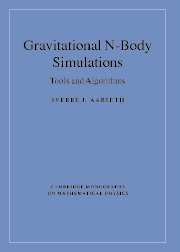Book contents
- Frontmatter
- Contents
- Preface
- 1 The N-body problem
- 2 Predictor–corrector methods
- 3 Neighbour treatments
- 4 Two-body regularization
- 5 Multiple regularization
- 6 Tree codes
- 7 Program organization
- 8 Initial setup
- 9 Decision-making
- 10 Neighbour schemes
- 11 Two-body algorithms
- 12 Chain procedures
- 13 Accuracy and performance
- 14 Practical aspects
- 15 Star clusters
- 16 Galaxies
- 17 Planetary systems
- 18 Small-N experiments
- Appendix A Global regularization algorithms
- Appendix B Chain algorithms
- Appendix C Higher-order systems
- Appendix D Practical algorithms
- Appendix E KS procedures with GRAPE
- Appendix F Alternative simulation method
- Appendix G Table of symbols
- Appendix H Hermite integration method
- References
- Index
3 - Neighbour treatments
Published online by Cambridge University Press: 18 August 2009
- Frontmatter
- Contents
- Preface
- 1 The N-body problem
- 2 Predictor–corrector methods
- 3 Neighbour treatments
- 4 Two-body regularization
- 5 Multiple regularization
- 6 Tree codes
- 7 Program organization
- 8 Initial setup
- 9 Decision-making
- 10 Neighbour schemes
- 11 Two-body algorithms
- 12 Chain procedures
- 13 Accuracy and performance
- 14 Practical aspects
- 15 Star clusters
- 16 Galaxies
- 17 Planetary systems
- 18 Small-N experiments
- Appendix A Global regularization algorithms
- Appendix B Chain algorithms
- Appendix C Higher-order systems
- Appendix D Practical algorithms
- Appendix E KS procedures with GRAPE
- Appendix F Alternative simulation method
- Appendix G Table of symbols
- Appendix H Hermite integration method
- References
- Index
Summary
Introduction
Most star clusters are characterized by large memberships that make direct N-body simulations very time-consuming. In order to study such systems, it is therefore necessary to design methods that speed up the calculations while retaining the collisional approach. One good way to achieve this is to employ a neighbour procedure that requires fewer total force summations. The AC neighbour scheme [Ahmad & Cohen, 1973, 1974] has proved very effective for a variety of collisional and collisionless problems. It is particularly suitable for combining with regularization treatments, where dominant particles as well as perturbers can be selected from the corresponding neighbour lists without having to search all the particles.
The AC method can also be used for cosmological simulations. The study of galaxy clustering usually employs initial conditions where the dominant motions are due to the universal expansion. By introducing comoving coordinates, we can integrate the deviations from the smooth Hubble flow, thereby enabling much larger time-steps to be used, at least until significant density perturbations have been formed. Naturally, such a direct scheme cannot compete with more approximate methods, such as the P3M algorithm [Efstathiou & Eastwood, 1981; Couchman, 1991] or the parallel tree code [Dubinski, 1996], which have been developed for large N, but in some problems the ability to perform detailed modelling may still offer considerable advantages.
- Type
- Chapter
- Information
- Gravitational N-Body SimulationsTools and Algorithms, pp. 32 - 50Publisher: Cambridge University PressPrint publication year: 2003

